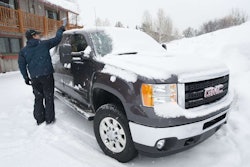 Goodyear Survey Indicates Drivers May Not Be Prepared This Winter
Goodyear Survey Indicates Drivers May Not Be Prepared This Winter
More than 75 percent of drivers believe winter tires make a difference, but 58 percent of those in cold-weather areas don’t use winter tires
Is it an intentional disregard for good advice? Is it a widespread belief that nothing matters past the Dec. 21 end date of the Mayan calendar? Perhaps it is a newfound sense of thrilling adventure after seeing a human free-fall from 24 miles above the Earth.
Whatever the reason, a new survey finds that people in North America may not have prepared themselves for … winter driving.
That’s right; drivers in North America may be underprepared when it comes to driving during the winter, according to a survey of drivers in major cold-weather markets conducted by The Goodyear Tire and Rubber Company.
The failure to be ready for what many believe is the most challenging driving season of the year comes from a general lack of adjustment to the frosty and slick conditions.
The survey finds that many drivers fail to equip and prepare their vehicles for winter, or even to slow down when driving.
Too few drivers take basic precautionary measures ahead of the season, such as getting their engine checked or switching to winter tires.
 Goodyear Ultra Grip Ice WRT is a good winter tire for pickups, greatly improving traction and vehicle control over “all-season,” “all-terrain” and “mud tires.”
Goodyear Ultra Grip Ice WRT is a good winter tire for pickups, greatly improving traction and vehicle control over “all-season,” “all-terrain” and “mud tires.”
According to the data, more than 75 percent believe winter tires make a difference in challenging winter weather, yet 58 percent of those in cold-weather areas don’t use winter tires.
These habits and perceptions are the same across drivers who have and haven’t been involved in any winter accidents.
“Simple things, such as equipping your car with a set of winter tires, can make the difference in challenging winter driving conditions,” said Brandy Gadd, marketing manager for Goodyear.
“A set of superior-performing winter tires, such as Goodyear’s Ultra Grip Ice WRT tires, helps provide consumers with the superior traction they need to confidently drive in ever-changing winter conditions.”
More than seven in ten (73 percent) respondents say they drive just as much in the winter, if not more often, than in other seasons, and 19 percent also claim they don’t drive any slower, even with often slippery road conditions.
During the winter months, this failure to prepare for changing winter weather could be the reason more than half of them (51 percent) actually fear other drivers more than the icy weather conditions.
In Quebec, where winter tires have been mandatory for drivers for the past five years, a 2011 study by the Ministry of Transport of Quebec has shown that winter tires make an impact on improving road safety.
A comparison of data from 2008-2009 and 2009-2010 with numbers for the five preceding years indicates a reduction in the number of crash victims during the years of mandatory winter tire versus the earlier years (a net reduction of 5 percent).
According to Goodyear’s survey, 23 percent of drivers wait until the first storm to put on winter tires, instead of doing it ahead of time, and 25 percent of drivers are unaware of the importance of putting winter tires on all four wheels. But even for those who equip their vehicles with winter tires, it is not enough to ensure a safe winter driving season.
Winter driving experts, such as Ian Law, owner of the ILR Winter Driving School, located in Mount Albert, Ontario, Canada, recommend these tips before you hit the road this winter:
- Get a Preseason Tire Examination: Check your tire pressure and tread – your tires need good traction to keep your car on the road. It’s important to have adequate tire tread – and in particularly cold climates, drivers should consider the use of winter tires.
- Drive Slow: Remember, just because you have superior traction doesn’t mean you can speed in snowy and icy conditions. When approaching intersections, stop signs, turns or any area where you have to decelerate, take your foot off the gas, apply the brakes gently and give yourself a cushion in case of slippery conditions.
- Invest in Winter Tires: Goodyear has Ultra Grip tires for optimal flexibility and grip in winter driving conditions, which not only includes snow, ice and slush, but also dry conditions when the temperature falls below 46F/7C. Leading Goodyear’s innovative winter tire line-up is the Ultra Grip Ice WRT, a premium line for cars, minivans, SUVs/CUVs and trucks that stops shorter on ice versus the leading competitor.*
- If snow is left on the hood, it can fly onto the windshield, obstructing your view. If snow is left on the roof, it can slide onto the rear window. Snow on the roof and tailgate can also fly off the car, especially at high speeds, affecting other cars.








